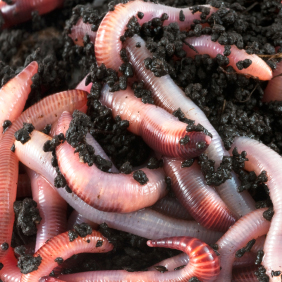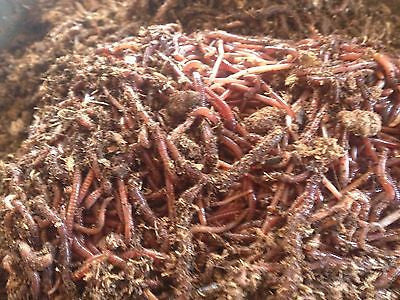The Duty of Red Wigglers in Lasting Gardening
The combination of red wigglers into lasting gardening techniques provides an engaging method to improving soil wellness and lowering natural waste. The implications of using red wigglers expand beyond simple composting; their duty in shaping an extra lasting future warrants a much deeper expedition of their advantages and practical applications.
Recognizing Red Wigglers
Red wigglers, medically called Eisenia fetida, are a varieties of earthworm renowned for their role in sustainable gardening and composting techniques - red wigglers. These worms thrive in disintegrating raw material, making them especially effective in converting cooking area scraps and yard waste right into nutrient-rich compost. Unlike conventional earthworms, red wigglers have a higher tolerance for differing wetness degrees and can prosper in environments with abundant organic material
The habitat choices of red wigglers consist of damp, dark settings rich in natural content, such as garden compost bins or worm ranches. Their ecological function extends beyond composting; they are indispensable in aerating the dirt and helping with vitamins and mineral cycling, which inevitably adds to much healthier yard environments. red wigglers. Understanding the biology and actions of red wigglers is important for those looking for to implement efficient vermicomposting in lasting horticulture
Benefits of Vermicomposting
Vermicomposting offers countless benefits that enhance sustainable horticulture practices and add to environmental wellness. One of the primary advantages is the transformation of organic waste into nutrient-rich garden compost, which boosts dirt structure and fertility. The castings created by red wigglers are loaded with valuable microorganisms and vital nutrients, making them a superb all-natural plant food.
Additionally, vermicomposting considerably minimizes land fill waste. By diverting kitchen scraps and yard waste from garbage dumps, this method not just decreases methane exhausts-- a powerful greenhouse gas-- yet also promotes a circular economic climate, where waste is repurposed as a source.
An additional benefit is the improvement of dirt oygenation and water drainage (red wigglers). The burrowing task of red wigglers develops networks in the dirt, permitting air and water to pass through even more conveniently, thus fostering a healthier root system for plants
Moreover, vermicomposting can be done on a small range, making it easily accessible for urban gardeners and those with limited room. This approach urges ecological stewardship and understanding, as individuals end up being much more engaged with their waste management techniques. Inevitably, vermicomposting stands for a sustainable, efficient, and environmentally friendly approach to horticulture that profits both plants and the world.
How to Beginning Vermicomposting
Beginning your own vermicomposting system can be a rewarding endeavor that enhances your lasting horticulture practices. To start, choose a suitable container, such as a plastic bin or wood box, with great drainage and air flow. The size will certainly depend on the quantity of kitchen area scraps you generate; a container of 10-14 gallons normally is sufficient for a household.
Following, prepare the bedding product. Shredded newspaper, cardboard, and coconut coir are excellent alternatives, offering a comfy habitat for the red wigglers. Aim for a bed linen depth of regarding 4-6 inches, which should be wet but not soaked.
Once the bed linen is established, introduce your worms. Red wigglers (Eisenia fetida) are one of the most appropriate for composting. Beginning with roughly one extra pound of worms for every 2-3 extra pounds of kitchen scraps weekly.
Begin including kitchen waste, preventing meat, milk, and oily foods, as these can draw in parasites and create smells. Regularly keep an eye on the container's wetness degrees and temperature, ensuring it continues to be within the perfect variety for worm task. With these initial actions, you'll be well on your means to creating nutrient-rich compost for your yard.
Maintaining a Healthy Worm Container
A thriving worm bin calls for consistent care and focus to maintain an ideal atmosphere for the red wigglers. Trick factors to keep an eye on consist of moisture degrees, temperature level, and food supply. Maintaining a moisture level comparable to a wrung-out sponge is essential; as well much water can lead to anaerobic blog conditions, while insufficient can dehydrate the worms.
Temperature is likewise critical, as red wigglers flourish in a series of 55 to 77 levels Fahrenheit. Extreme temperatures can worry the worms, potentially causing mortality. Positioning the container in a climate-controlled location or utilizing protecting products can aid regulate temperature fluctuations.

Finally, aeration is essential. Consistently turning the bedding and making use of a fork or shovel can avoid compaction and advertise air flow, guaranteeing a healthy and balanced, successful environment for the red wigglers. By sticking to these practices, garden enthusiasts can maintain an effective worm bin that sustains sustainable horticulture efforts.
Effect On Soil Wellness
Enhancing soil wellness with making use of red wigglers is an essential facet of sustainable horticulture. These worms, known clinically as Eisenia fetida, play an essential duty in improving dirt framework and fertility. By consuming natural matter, red wigglers break down intricate materials into less complex compounds, a process referred to as vermicomposting. The end product, worm spreadings, is abundant in vital nutrients, consisting of nitrogen, phosphorus, and potassium, which are important for plant development.


Conclusion
To conclude, red wigglers considerably add to sustainable gardening via their reliable vermicomposting techniques. Their capacity to transform natural waste right into nutrient-rich compost improves soil fertility and supports a varied microbial ecological community. Additionally, their burrowing activity improves dirt oygenation and water retention, benefiting plant health and wellness. By advertising waste decrease and promoting a circular economy, red wigglers arise as necessary elements in environment-friendly gardening initiatives, emphasizing their crucial function in environmental sustainability.
Comments on “Red wigglers: Their role in reducing waste”